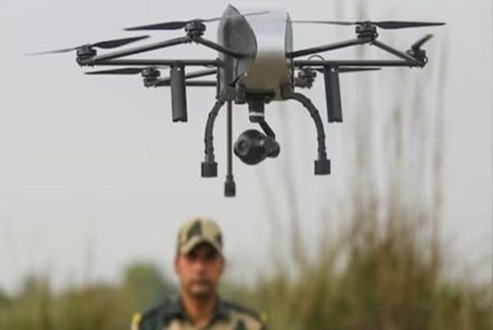| (Mains, General Studies Paper-3: Challenges to Internal Security through Communication Networks, Role of Media and Social Networking Sites in Internal Security Challenges, Basics of Cyber Security, Money Laundering and its Prevention) |
Reference
The Indian Army is building an AI Roadmap for the integration of Artificial Intelligence (AI), Machine Learning (ML) and Big Data Analytics in its operations by 2026-27. It aims to enhance battlefield awareness, decision-making and combat preparedness in line with India’s vision of modernization of defence capabilities.

Key Features of AI Roadmap
Features
- Drone Swarming: These enable AI-powered drone swarms for coordinated operations, reconnaissance, target engagement and saturation attacks.
- These drones enhance accuracy in complex battlefields with automatic navigation, collision avoidance and automatic target recognition capabilities.
- Real-time battlefield surveillance: AI tools process data from drones, satellites, aircraft and terrestrial sensors to provide real-time situational awareness, enabling faster and more informed decision-making.
- Smart War Rooms: Deploy AI-powered decision support systems, including Large Language Model (LLM)-based text summarization, AI chatbots, voice-to-text systems and facial recognition tools to summarize reports, detect threats and streamline command operations.
- Battle Simulation and Training: AI-based simulations for military training, combat exercises and mapping adversary capabilities will enhance operational preparedness.
- Logistics and Intelligence: Promote the use of AI to analyze open source intelligence (OSINT) and social media to optimize supply chains, predictive maintenance and counter misinformation and enhance surveillance.
- Anti-drone and electronic warfare: Development of AI-powered unmanned aerial systems (C-UAS) and electronic warfare suites to disrupt enemy communications and radars.
Strategic requirement
- Learnings from Operation Sindoor: The operation exposed vulnerabilities where adversaries leveraged real-time drone and satellite inputs. It highlighted the need for AI-powered systems to match or surpass enemy capabilities.
- Boost indigenisation: Emphasis on domestic AI and drone development through collaboration between the military, industry and academia.
- Directorate General of Information Systems (DGIS) is setting up an AI lab to integrate these technologies across the services.
- Self-reliance: Chief of Defence Staff General Anil Chauhan emphasised on indigenous counter-unmanned aerial systems tailored to Indian terrain to reduce dependence on foreign technology to ensure scalability and security.
Implementation Framework
- Timeline: Full integration by 2026-27 with specific tactical, operational and strategic goals
- Task Force: Creation of a special task force comprising AI experts under the Directorate General of Information Systems to oversee training, data integration and maintenance of AI systems
- Integration: All new equipment has AI features built in, ensuring long-term adaptation.
Challenges
- Limited robust datasets for AI training
- Ethical concerns related to autonomous weapon
- Need to replace obsolete hardware
Way Forward
- Accelerate indigenous AI and drone development through collaboration with startups and academia
- Invest in anti-drone systems and electronic warfare capabilities to counter adversary advancements
- Incorporate AI in military operations to address accountability concerns Strengthening ethical frameworks for the use of
- This roadmap positions the Indian Army to leverage cutting edge technology for a future ready and self-reliant Army, which is vital for national security in a rapidly evolving global scenario.